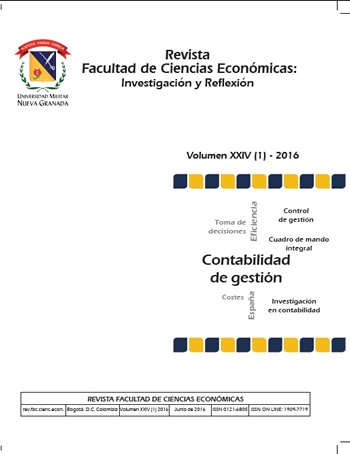Impacto do revenue management nos sistemas de controle de gerenciamento
Resumo
O Revenue Management (RM) tem por objeto prever a demanda de produtos ou serviços da maneira mais precisa possível, a fim de poder estabelecer e adaptar as decisões de preço e disponibilidade de produtos, nos diferentes canais de venda, e maximizar a rentabilidade. O RM trata de maximizar o rendimento que pode atingir uma empresa com uma capacidade fixa de fabricação de um produto ou de prestação de um serviço. Assim, o objetivo é tratar de destinar a capacidade àqueles clientes que contribuem com maior valor à empresa, atribuindo-lhes a capacidade adequada. Neste contexto de ação costuma-se aludir, constantemente, à necessidade de gerar um resultado, ou atingir uma rentabilidade. No entanto para estes efeitos só se tomam em consideração os custos variáveis, e em menor medida os custos fixos, o que nos leva a propor a seguinte pergunta: Qual o impacto do método de cálculo de custos nos processos de gerenciamento de rendimentos? Esta é a questão que indica o objetivo do presente artigo, ao identificar quais são as inter-relações que existem entre a contabilidade de gerenciamento e o RM, dado que ambas as perspectivas são complementares no lucro de um objetivo comum, como é procurar a maior eficiência e efetividade econômica das operações desenvolvidas por qualquer empresaDownloads
Referências
Anderson, C. K. & Wilson, J.G. (2003). Wait or buy? The strategic consumer. Pricing and profit implications. Journal of the Operational Research Society, 52 (3), 299-306
Benigno, S., Guerriero, F. & Miglionico, G. (2012). A revenue management approach to address a truck rental problem. Journal of the Operational Research Society, 63(10), 1421–1433.
Besana, A. (2012). Alternative Resources: Revenue Diversification in the Not-for-Profit USA Symphony Orchestra. The Journal of Arts Management, Law, and Society, 42, 79–89.
Boyd, E. A., & Bilegan, I. C. (2003). Revenue Management and E-Commerce. Management Science, 49(10), 1363–1386.
Boyd, E. (2007). The future of pricing: How airline ticket pricing has inspired a revolution. New York. Palgrave. MacMillan.
Buckhiester, B. (2011). Revenue Management as a Multi-Disciplinary Business Process: Part One. The Journal of Hospitality Financial Management, 19(1), 91–103.
Bujisic, M., Hutchinson, J. & Bilgihan, A. (2014). Journal of Foodservice Business The Application of Revenue Management in Beverage Operations. Journal of Foodservice Business Research, 17, 336–352.
Cheraghi, S. H., Dadashzadeh, M. & Venkitachalam, P. (2010). Revenue Management In Manufacturing: A Research Landscape. Journal of Business & Economics Research, 8(2), 63–72.
Ciancimino, A., Inzerillo, G., Lucidi, S. & Palagi, L. (1999). A Mathematical Programming Approach for the Solution of the Railway Yield Management Problem. Transportation Science, 33(2), 168–181.
Cross, R.G. (1997). Revenue management: Hard-core tactics for market domination. New York; Broadway Books.
Gallien, J. & Wein, L. M. (2005). A Smart Market for Industrial Procurement with Capacity Constraints. Management Science, 51, 76–91.
Guadix, J., Onieva, L., Muñuzuri, J. & Cortés, P. (2011). An overview of revenue management in service industries: an application to car parks. The Service Industries Journal, 31(1),
Huefner, R. J. (2011). A Guide to Integrating Revenue Management and Capacity Analysis. Management Accounting Quarterly, 13, 40–46.
Huefner, R. J. & Largay, J. a. (2008). The role of accounting information in revenue management. Business Horizons, 51, 245–255.
Karmarkar, S. & Dutta, G. (2012). Multi-period revenue management model for internet advertising. Journal of Revenue and Pricing Management, 11(2), 225–239.
Kimes, S.E. (2005). A strategic approach to yield management. In A. Ingold; U. McMahon-Beattle; I. Yoeman . Yield management strategic for the services industries. 2nd Ed. Londond. Thomson Learning, 3-14.
Kumar, S. & Frederick, J. L. (2007). Revenue management for a home construction products manufacturer. Journal of Revenue and Pricing Management, 5, 256–270.
Leask, A., Fyall, A. & Garrod, B. (2013). Managing revenue in Scottish visitor attractions. Current Issues in Tourism, 16(3), 240–265.
McGill, J. & Van Ryzin, G. (1999). Revenue Management: Research Overview and Prospects. Transportation Science, 33(2), 233–256.
Milani, J. (2012). Improving Revenues in Financial Services Through Customer Service and Revenue Management (CSRM)®. Journal of Performance Management, 24, 3–15.
Ng, I. C. L. & Yip, N. K. T. (2011). Mechanism design in an integrated approach towards revenue management: the case of Empress Cruise Lines. The Services Industries Journal, 31(3), 469–482.
Ovchinnikov, A. & Milner, J. M. (2010). Revenue management with end-of-period discounts in the presence of customer learning. Production and Operations Management, 21(June), 69–84.
Phillips, R.L. (2005). Pricing and revenue optimization. Stanford, CA; Stanford University Press.
Queenan, C. C., Ferguson, M. E. & Stratman, J. K. (2011). Revenue management performance drivers: An exploratory analysis within the hotel industry. Journal of Revenue and Pricing Management, 10(2), 172–188.
Schönberger, J. & Kopfer, H. (2012). Revenue management in road-based freight transportation: Impacts of uncertainty of capacity consumption. International Journal of Physical Distribution & Logistics Management, 42(4), 388–403.
Shields, J. (2006). Revenue management: A strategy for increasing sales and revenue in small business. Journal of Small Business Strategy. 16 (2), 43-53.
Smith, B.C., Leimkuhler, J.M. & Darrow, R.M. (1992) Yield management at American Airlines. Interfaces, 22 (1), 8-31.
Swan, J. H., Hunter, H. R. & Tumelty, R. (1997). Medicare Revenue in Large Medical Groups. Journal of Healthe & Social Policy, 9(1), 23–44.
Talluri, K. & van Ryzin, G. (2004). Revenue Management Under a General Discrete Choice Model of Consumer Behavior. Management Science, 50, 15–33.
Ting, S.-C. & Tzeng, G.-H. (2004). An optimal containership slot allocation for liner shipping revenue management. Maritime Policy & Management, 31(July-September), 199–211.
Vercio, A., Bayliss, A. & Thompson, L. L. (2005). Fourteen types of idle capacity. Cost Management, July - Aug, 35–39.
Wang, X. L. & Bowie, D. (2009). Revenue management: the impact on business-to-business relationships. Journal of Services Marketing, 23(January), 31–41.
Wirtz, J., Kimes, S.E., Pheng Theng, J.H. & Patterson, P. (2003) Revenue management - Involving potential customer conflicts. Journal of Revenue & Pricing Management, 2 (3), 216-226.
Withiam, G. (2001). The 4 C strategy for yield management. Center for Hospitality Research Report. Ithaca, NY; Cornell University.
Zhang, M. & Bell, P. (2012). Price fencing in the practice of revenue management: An overview and taxonomy. Journal of Revenue and Pricing Management, 11(2), 146–159.
Zurheide, S. & Fischer, K. (2012). A revenue management slot allocation model for liner shipping networks. Maritime Economics & Logistics, 14(3), 334–361.











